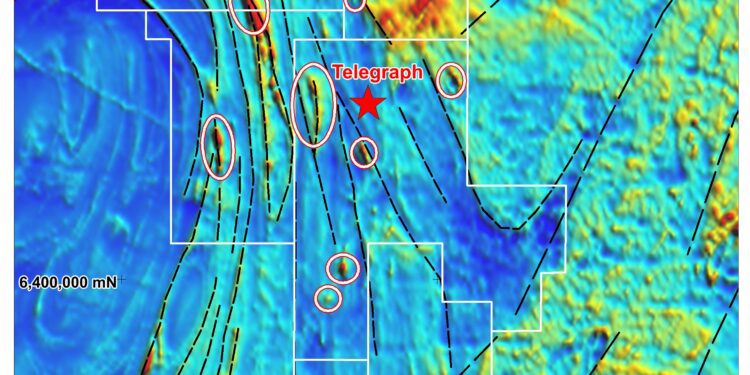Multi-Element Geochemical Anomalies In AC Drilling
AusQuest Limited (ASX: AQD) has identified a series of largescale base metal targets following recently completed reconnaissance air-core drilling at the Balladonia Copper-Nickel Project in the Fraser Range region of Western Australia.
The drilling returned anomalous nickel-copper values associated with an interpreted ultramafic intrusion, as well as identifying potential for Broken Hill Type (BHT) and/or ironoxide copper-gold (IOCG) mineralisation associated with magnetic targets.
A total of 54 air-core holes for 1,110m were completed along selected traverse lines between 400-800m apart, to provide a first-pass evaluation of four magnetic targets.
Three of these were considered as possible IOCG and/or BHT targets similar to those found in the Eastern Succession of north-west Queensland, and one (a magnetic low) was considered to be a possible ultramafic intrusion, similar to those that host nickel-copper mineralisation elsewhere in the Fraser Range.
Air-core drilling (on 400m x 100m spacing) over the newly-named Harms Lake Prospect intersected a thick section (~50m) of highly weathered rocks (saprolite) coincident with the magnetic target, with seven of the holes containing anomalous levels of nickel (up to 1,680ppm Ni), copper (up to 450ppm Cu) and chrome (up to 2,500ppm Cr) – suggesting a close affinity with ultramafic rock types and the potential for nickel-copper sulphides beneath the saprolite/
Elevated rare earth elements were also reported in several drill-holes (up to 1,600ppm Ce, 620ppm La, 380ppm Y), suggesting a possible association with carbonatite intrusions – as was found to be the case at the Company’s Telegraph prospect, located ~16km to the south.
At the newly-named Tea Tree Prospect, two reconnaissance lines of air-core drilling (on 800m x 100m spacing) were completed across the magnetic target. Hole depths varied from ~5m to 28m, with the majority of holes ending in saprolite.
Two drill-holes intersected recognisable bedrock (garnet gneiss), with both holes returning anomalous pathfinder geochemistry – including elevated lead (119ppm Pb), zinc (280ppm Zn), tin (9.5ppm Sn), molybdenum (25ppm Mo), and cadmium (3.0ppm Cd) in drill-hole BDAC110, within a garnet gneiss that had been subjected to iron (Fe), manganese (Mn) and potassic (K) alteration.
The geochemically anomalous drill-holes are located within a package of strongly magnetic rocks which likely include ironstone (BIF) units. Similar packages of rocks are often associated with base metal mineralisation in the Eastern Succession of north-west Queensland, where a number of BHT and IOCG deposits have been discovered. The Balladonia Project is subject to the Strategic Alliance Agreement (SAA) with a wholly-owned subsidiary of South32. Further exploration in the Balladonia area is currently being planned under the SAA.
AusQuest’s Managing Director, Graeme Drew, said the air-core results highlighted the opportunity to discover significant base metal mineralisation at Balladonia.
“Comparisons that can be made with base metal deposits in north-west Queensland, as well as nickel-copper deposits found in the Fraser Range, continue to provide us with optimism for new discoveries to be made in this area,” he said.
“Given the extensive cover that is present, exploration in this area is still in its infancy – and the more we learn about the area, the closer we get to hopefully making a discovery.” “We are continuing to work closely with our Alliance partner to explore the Balladonia Project and look forward to advising shareholders of our future plans once all the data generated by these recent exploration programs have been fully assessed,” he said.
For further information please visit: http://www.ausquest.com.au












